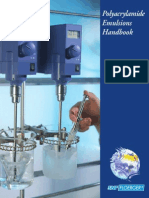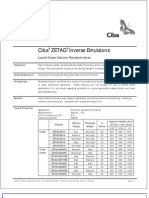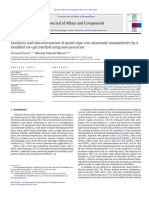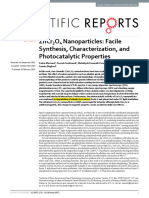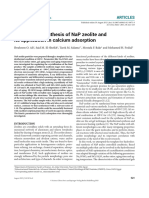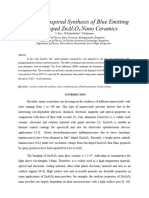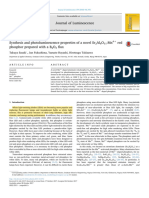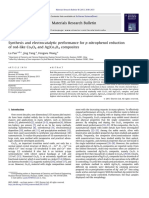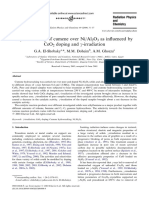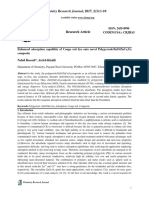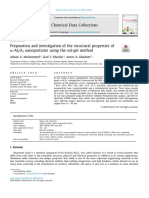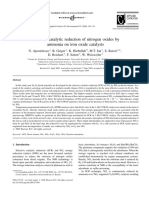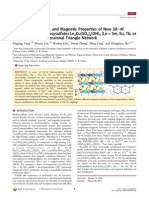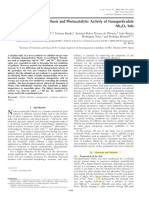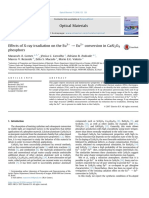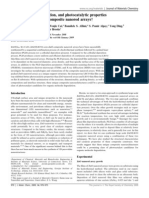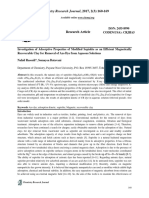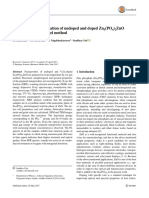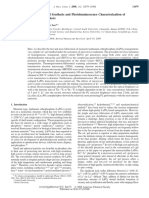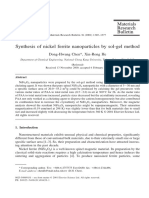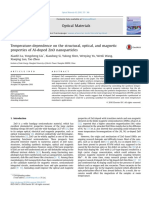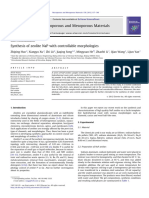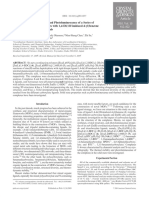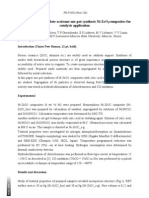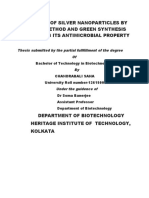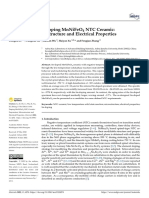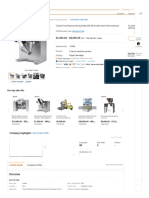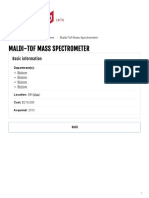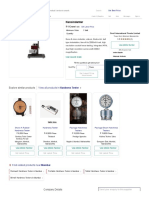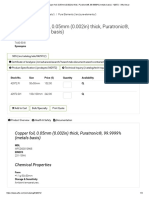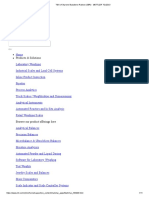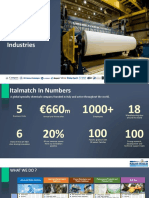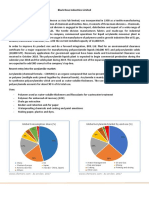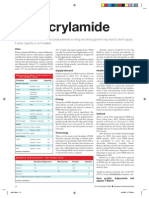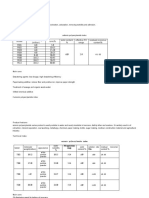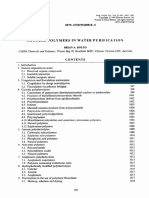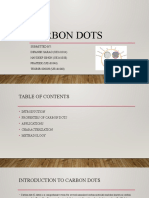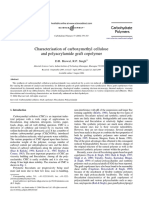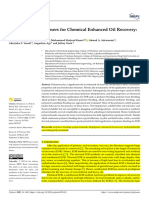Wang 2015
Wang 2015
Uploaded by
Salma FarooqCopyright:
Available Formats
Wang 2015
Wang 2015
Uploaded by
Salma FarooqOriginal Description:
Copyright
Available Formats
Share this document
Did you find this document useful?
Is this content inappropriate?
Copyright:
Available Formats
Wang 2015
Wang 2015
Uploaded by
Salma FarooqCopyright:
Available Formats
www.nature.
com/scientificreports
OPEN A comparative study of ZnAl2O4
nanoparticles synthesized from
different aluminum salts for use as
received: 21 January 2015
accepted: 08 July 2015
Published: 04 August 2015
fluorescence materials
Shi-FaWang1,2, Guang-ZhuangSun1,2, Lei-MingFang2, LiLei3, XiaXiang1 & Xiao-TaoZu1
Three ZnAl2O4 samples were prepared via a modified polyacrylamide gel method using a citric acid
solution with different aluminum salt starting materials, including AlCl36H2O, Al2(SO4)318H2O,
and Al(NO3)39H2O under identical conditions. The influence of different aluminum salts on the
morphologies, phase purity, and optical and fluorescence properties of the as-prepared ZnAl2O4
nanoparticles were studied. The experimental results demonstrate that the phase purity, particle
size, morphology, and optical and fluorescence properties of ZnAl2O4 nanoparticles can be
manipulated by the use of different aluminum salts as starting materials. The energy bandgap (Eg)
values of ZnAl2O4 nanoparticles increase with a decrease in particle size. The fluorescence spectra
show that a major blue emission band around 400nm and two weaker side bands located at 410 and
445nm are observed when the excitation wavelength is 325nm. The ZnAl2O4 nanoparticles prepared
from Al(NO3)39H2O exhibit the largest emission intensity among the three ZnAl2O4 samples,
followed in turn by the ZnAl2O4 nanoparticles prepared from Al2(SO4)318H2O and AlCl36H2O. These
differences are attributed to combinational changes in Eg and the defect types of the ZnAl2O4
nanoparticles.
Spinel ZnAl2O4 is known to have a wide energy bandgap (Eg), high mechanical resistance, high fluores-
cence efficiency, high chemical and thermal stability, high photocatalytic activity, and low surface acidity,
all of which make it a suitable material for a wide range of applications, including use in photoelectronic
devices, catalysts, electroluminesence displays, stress imaging devices, optical coatings, and highly effi-
cient phosphors13. Based on the above mentioned applications, various morphologies of spinel ZnAl2O4
have been prepared, including one-dimensional microfibers, porous structures, nanoparticles, nanorods,
nanotubes, and so on48. It has been noted that the optical properties of these materials are strongly
dependent on their morphologies and preparation methods. In particular, ZnAl2O4 nanostructures
are expected to exhibit enhanced optical and fluorescence properties usually absent in bulk ZnAl2O4.
Therefore, the preparation and study of the optical and fluorescence properties of ZnAl2O4 nanostructure
powder is of great interest.
Spinel ZnAl2O4 semiconductors have been synthesized using a variety of different methods, such as
the solid-state reaction method9,10, a self-generated template pathway9, the combustion synthesis route11,
the solgel method12, a co-precipitation approach6, the polymeric precursor method13, the citrate pre-
cursor method4, a hydrothermal process7, a solvothermal approach14, and the microwave-hydrothermal
route15. The particle size of ZnAl2O4 has a large effect on its optical and fluorescence properties. Generally,
1
School of Physical Electronics and Institute of Fundamental and Frontier Sciences, University of Electronic Science
and Technology of China, Sichuan, Chengdu, 610054, China. 2Institute of Nuclear Physics and Chemistry, China
Academy of Engineering Physics, Sichuan, Mianyang, 621900, China. 3Institute of Atomic and Molecular Physics,
Sichuan University, 610065, Chengdu, China. Correspondence and requests for materials should be addressed to
X.T.Z. (email: xtzu@uestc.edu.cn)
Scientific Reports | 5:12849 | DOI: 10.1038/srep12849 1
www.nature.com/scientificreports/
Figure 1. XRD patterns of ZnAl2O4 nanoparticles prepared from (S1) Al2(SO4)318H2O, (S2)
AlCl36H2O, and (S3) Al(NO3)39H2O and sintered at 600C.
smaller particles have a relatively larger specific surface area, and therefore have a larger amount of dan-
gling and unsaturated bonds on the particle surface. This in turn affects the defect levels and fluores-
cence properties of the powder16. However, the main disadvantage of preparing spinel ZnAl2O4 by the
traditional synthesis routes, such as the co-precipitation approach, the solid-state reaction method, and
others, is the large particle size of the product.
The polyacrylamide gel route is a very good sol-gel method for the preparation of superfine nanopar-
ticles17. Appropriate selection of a chelating agent, monomer systems, initiator, pH value, and sintering
temperature can significantly improve the quality of the prepared nanoparticles17. In addition, different
aluminum salts, i.e. different anionic species in the precursor solutions, can greatly influence the mor-
phology, phase purity, and optical and fluorescence properties of the ZnAl2O4. However, most previously
reported studies have only used a single aluminum salt as a starting material and have not investigated
the influences of different aluminum salts on the morphology, structure, and optical and fluorescence
properties of the obtained ZnAl2O4.
In this study, three different aluminum salts are used as starting materials to synthesize three ZnAl2O4
gels via a polyacrylamide gel route, specifically aqueous solutions of citric acid with Al2(SO4)318H2O,
AlCl36H2O, or Al(NO3)39H2O were used under identical conditions. In order to obtain superfine nan-
oparticles, N,N-methylene-bisacrylamide was used as a cross-linking agent, and glucose was used to
prevent gel collapse. After sintering these xerogels, three ZnAl2O4 nanostructure samples were obtained.
Their phase purity, morphologies, and optical and fluorescence properties were then characterized and
compared. The objective of the present work is to investigate the influence of different aluminum salt start-
ing materials on the resulting ZnAl2O4 nanostructures and on their optical and fluorescence properties.
Results
The obtained ZnAl2O4 xerogels decomposed into products after being sintered at 600C for 5h in air.
Figure 1 shows the XRD patterns of ZnAl2O4 nanoparticles prepared from (S1) Al2(SO4)318H2O, (S2)
AlCl36H2O, and (S3) Al(NO3)39H2O. It can be seen that samples S1 and S2 have crystallized in a sin-
gle phase with a spinel structure and with space group O7h, but sample S3 contains small amounts of
ZnO (JCPDS card No. 361451) impurities in addition to the major phase of spinel ZnAl2O4 structure
(JCPDS card No. 050669). According to the literature2,18, the relevant reactions can be described by the
following equations:
4Zn (NO3 )2 6H 2O + 4Al 2 (SO 4 )3 18H 2 O + 4C 6 H8 O7 + 4C6 H12 O6 + 4C3 H5 ON
600 C
+ 4C7 H10 N 2 O 2 + 4NH3 H 2 O + 75O 2
4ZnAl 2O 4 + 10N 2 + 88CO 2 + 170H 2 O
+ 12SO 2 + 4NH3 ( 1)
4Zn (NO3 )2 6H 2O + 8AlCl 3 6H 2O + 4C 6H8O7 + 4C 6H12O6 + 4C 3H5ON + 4C 7H10N 2O 2
600 C
+ 24NH3 H 2O + 81O 2
4ZnAl 2O 4 + 10N 2 + 88CO 2 + 154H 2 O + 24NH3
+ 24HCl (2)
Scientific Reports | 5:12849 | DOI: 10.1038/srep12849 2
www.nature.com/scientificreports/
Figure 2. FT-IR spectrum of ZnAl2O4 nanoparticles prepared from (S1) Al2(SO4)318H2O, (S2)
AlCl36H2O, and (S3) Al(NO3)39H2O and sintered at 600C.
8Zn (NO3 )2 6H 2O + 8Al (NO3 )3 9H 2O + 4C 6H8O7 + 4C 6H12O6 + 4C 3H5ON
+ 4C 7H10N 2O 2 + 4NH3
600 C
H 2O + 41O 2
4ZnO + 4ZnAl 2O 4 + 26N 2 + 88CO 2 + 194H 2O + 4NH3 (3)
For samples S1 and S2, the observed diffraction peaks at 2 are 31.22, 36.77, 44.69, 48.98, 55.52, 59.27,
65.06, 73.97, and 77.12 and can be ascribed, respectively, to the (220), (311), (400), (331), (422), (511),
(440), (620), and (533) planes of ZnAl2O4. The mean grain size of samples S1, S2, and S3 were quan-
titatively evaluated based on the line broadening of the (220), (311), (511), and (440) peaks using the
Scherrer formula, to be 13, 16, and 24nm, respectively. XRD results indicate that the choice of the
aluminum salts also has an influence on the phase purity of the final product. A possible reason for the
formation of impurity phases when using citric acid as a chelating agent is that citric acid has a relatively
weak coordinating capacity toward the metal ion of Al(NO3)39H2O, and hence the formed metal com-
plexonate is not expected to be highly stable.
Fourier transform infrared (FT-IR) spectra of the ZnAl2O4 nanoparticles prepared from (S1)
Al2(SO4)318H2O, (S2) AlCl36H2O, and (S3) Al(NO3)39H2O are shown in Fig.2. The FT-IR spectra show
a series of absorption peaks in the range of 4002000cm1. According to the specific frequencies of the
absorption peaks, the functional groups existing in the samples can be deduced. Peaks at 1633, 656, 552,
and 493cm1 are present in all samples, and are assigned to the H-O-H bending vibration of adsorbed
water19, Al-O symmetric stretching vibration (1)1922, Al-O symmetric bending vibration (2)1922, and
Al-O asymmetric stretching vibration (3)21,22, respectively. For sample S2, the peaks located at 1186 and
1117cm1 are attributed to the S=O asymmetric stretching vibration23 and the S-O symmetric stretching
vibration23,24, respectively.
Figure 3 shows the TG/DTA curves of the ZnAl2O4 xerogels obtained from (S1) Al2(SO4)318H2O,
(S2) AlCl36H2O, and (S3) Al(NO3)39H2O. There are four weight loss stages observed for each sample.
The first weight loss stage is seen at a low temperature range (before 200C) and corresponds to the
evaporation of surface water in the ZnAl2O4 xerogel precursors25,26. The second weight loss stage (around
200250C) is due to the evaporation of structural water25,26. The third weight loss stage (between 250
400C) is due to the decomposition of small molecular organic compounds. The largest and final weight
loss stage (around 400620C) is due to decomposition of complexes, glucose, and the polyacrylamide
side-chain, as well as combustion of the polyacrylamide backbone and other residues27,28. The total
weight loss measured for the ZnAl2O4 xerogel precursors were 97.31% for (S1) Al2(SO4)318H2O, 95.201%
for (S2) AlCl36H2O, and 98.234% for (S3) Al(NO3)39H2O. In Fig. 3 (S1), the main endothermic peak
appeared at around 535 C and corresponds to the thermal decomposition of the complexes, polyacryla-
mide backbone, and other residues originating from Al2(SO4)3 18H2O. Meanwhile, the main endother-
mic peaks appeared at 557C (Fig.3(S2)) for the ZnAl2O4 xerogel precursor obtained from AlCl36H2O,
and at 528C (Fig.3(S3)) for (S3) Al(NO3)39H2O. The slightly different decomposition temperatures of
the three ZnAl2O4 xerogels may be related to differences in the microstructures caused by the presence
of different anionic species (Cl, SO42, and NO3) in the synthesis process. The chemical reaction is
complete at ~600/620C and results in the formation of ZnAl2O4 nanoparticles. However, for ZnAl2O4
Scientific Reports | 5:12849 | DOI: 10.1038/srep12849 3
www.nature.com/scientificreports/
Figure 3. TG/DTA curves of ZnAl2O4 xerogel prepared from (S1)Al2(SO4)318H2O, (S2) AlCl36H2O, and
(S3) Al(NO3)39H2O.
nanoparticles prepared from Al2(SO4)318H2O, a higher heat treatment temperature is usually needed to
improve the phase purity.
To confirm whether the formation of ZnAl2O4 nanoparticles prepared from Al2(SO4)318H2O needed
a higher heat treatment temperature, FT-IR measurements were carried out using a Bruker IFS 66v/S
spectrometer. The FT-IR spectra of the ZnAl2O4 xerogel prepared form Al2(SO4)318H2O and sintered at
different temperatures are presented in Fig.4. Here is can be seen that the S=O asymmetric stretching
vibration (1186cm1) and S-O symmetric stretching vibration (1117cm1) peak intensities decrease with
the increase of sintering temperature. This result indicates that the SO42 anion coordinates to Zn and
Al cations and forms a bridged bidentate structure23,29,30.
In the case of the sample obtained by sintering the xerogel at 900C, all of the organic peaks disappear
except for the HOH peak (1633cm 1). These results indicate that the effects of aluminum salts and
sintering temperature on the phase purity of ZnAl2O4 cannot be neglected. Based on the subtle infor-
mation gathered from the XRD and FT-IR results, the relevant reactions can be described as follows:
Scientific Reports | 5:12849 | DOI: 10.1038/srep12849 4
www.nature.com/scientificreports/
Figure 4. FT-IR spectrum of ZnAl2O4 xerogel prepared from Al2(SO4)318H2O and sintered at 700, 800,
and 900C.
4Zn (NO3 )2 6H 2O + 4Al 2 (SO 4 )3 18H 2 O + 4C 6 H8 O7 + 4C6 H12 O6 + 4C3 H5 ON
+ 4C7 H10 N 2 O 2 + 4NH3
600 800 C
HO 2 + 79O 2 4SO 4 2 / ZnAl 2O 4 + 10N 2 + 88CO 2 + 170H 2O + 8SO 2 + 4NH3 ( 4)
900 C
SO 4 2/ ZnAl 2O 4
ZnAl 2O 4 + SO 2 + O 2 (5)
The results indicate that the reaction (1) cannot occur at 600C, and that a higher sintering temper-
ature is needed for the formation of pure ZnAl2O4 nanoparticles.
In order to investigate the effects of different aluminum salts on the formation of ZnAl2O4, including
the particle size and surface morphology, SEM and TEM images were collected of the ZnAl2O4 samples
prepared using different aluminum salts and sintered at 700C, and are shown in Fig.5 and Fig.6. The
SEM images of the ZnAl2O4 samples reveal that the particles are almost spherical in shape and have a
narrow particle size distribution (Fig.5(S1S3)). When AlCl36H2O is added into the ZnAl2O4 precursor,
large particles form, however, if Al2(SO4)318H2O is added into the precursor, small particles with little
adhesion are observed, as shown in Fig.5(S1-S2).
Figure 6 shows (S1S3) TEM image, (SH1- SH3) HRTEM image, and (SP1SP3) the particle size
distribution of ZnAl2O4 nanoparticles prepared from (S1) Al2(SO4)318H2O, (S2) AlCl36H2O, and
Al(NO3)39H2O. The ZnAl2O4 nanoparticles are spherical in shape with a narrow particle size distribu-
tion, as shown in Fig. 6(S1S3). The corresponding particle size distribution patterns are given in the
Fig. 6 (SP1SP3). The average particle sizes of samples S1, S2, and S3 are around 12, 18, and 24nm,
respectively. TEM results show that the particle size variation tendencies for samples S1, S2, and S3 are
consistent with those calculated from XRD patterns (Fig. 1). In addition, the BET surface area of the
sample decreases with the increase of particle size as shown in Table1. Compared with sample S2, the
average particle size and BET surface area of sample S1 is significantly reduced, an effect which may
be due to the SO42 anion forming a bridged bidentate structure31. Fig.6(S2) inset presents the SAED
pattern taken from a portion of the ZnAl2O4 nanoparticles shown in Fig.6(S2). The associated electron
diffraction pattern is consistent with that of pure ZnAl2O4 crystals of a spinel structure, indexed as shown
in Fig. 1(a). The SAED pattern revealed that the ZnAl2O4 nanoparticles possess interplanar spacings
of 2.8235, 2.4156, 2.0205, 1.6328, 1.5531, and 1.4203 corresponding to the (220), (311), (400), (422),
(511), and (440) planes, respectively.
Figure 6 (SH1)-(SH3) shows the HRTEM image of ZnAl2O4 nanoparticles prepared from (S1)
Al2(SO4)318H2O, (S2) AlCl36H2O, and (S3) Al(NO3)39H2O. For these samples, the lattice planes of
ZnAl2O4 nanoparticles were (111) with a lattice space of 4.6687, (220) with a lattice space of 2.8437,
(222) with a lattice space of 2.3345, (400) with a lattice space of 2.0210, (331) with a lattice space
of 1.8550, and (440) with a lattice space of 1.4356. It has been noted that (111), (220), (222), (400),
(331) and (440) planes can be attributed to spinel ZnAl2O4 structure corresponding to JCPDS card No.
050669.
Figure 7(a) shows the UV-Vis diffuse reflectance spectra of ZnAl2O4 samples prepared from (S1)
Al2(SO4)318H2O, (S2) AlCl36H2O, and (S3) Al(NO3)39H2O. Considering that ZnAl2O4 is a direct band-
gap semiconductor32, the Eg of the ZnAl2O4 samples can be estimated from plots of (h)2 versus h
Scientific Reports | 5:12849 | DOI: 10.1038/srep12849 5
www.nature.com/scientificreports/
Figure 5. SEM images and particle size distribution of ZnAl2O4 xerogel prepared from (S1)
Al2(SO4)318H2O, (S2) AlCl36H2O, and (S3) Al(NO3)39H2O and sintered at 700C.
using the Tauc relation33. This is shown in Fig.7(b), where h is the Planck constant, is the Kubelka
Munk (KM) absorption coefficient, and is the frequency. The linear portions of the plots are extrap-
olated to the h axis to give the values of Eg. The calculated Eg values of samples S1, S2, and S3 are
3.980.01, 3.920.01 and 3.220.01eV, respectively. Generally, the Eg values of nano-sized semicon-
ductors increase with a decrease in particle size. In this case, the observed phenomenon is consistent
with what has been previously reported.
Scientific Reports | 5:12849 | DOI: 10.1038/srep12849 6
www.nature.com/scientificreports/
Figure 6. (S1S3) TEM image, (SH1- SH3) HRTEM image, and (SP1SP3) Particle size distribution of
ZnAl2O4 nanoparticles prepared from (S1) Al2(SO4)318H2O, (S2) AlCl36H2O, and (S3) Al(NO3)39H2O
and sintered at 700C. The inset presents the SAED pattern taken from a portion of the ZnAl2O4
nanoparticles shown in Fig.6(S2).
BET specific
Crystallite Particle Eg surface area
Sample size (nm) size (nm) (eV) (m2/g)
S1 13 12 3.98 40.13
S2 16 18 3.92 27.75
S3 24 24 3.22 19.38
Table 1. Crystallite size, particle size, Eg and BET specific surface area of samples S1, S2 and S3.
Figure8(a) show the fluorescence spectra of ZnAl2O4 samples prepared from (S1) Al2(SO4)318H2O,
(S2) AlCl36H2O, and (S3) Al(NO3)39H2O and sintered at 700C. The fluorescence spectra with a wave-
length range of 385~445nm for all samples are presented after excitation with light, exc=325nm. The
fluorescence spectrum of the ZnAl2O4 sample is wide and can be resolved using three Gaussian peaks
at 400, 410, and 445nm (Fig.8b). The three emission peaks at 400, 410, and 445nm can be ascribed to
intra band gap defects such as oxygen vacancies34. It has been noted that there is an obvious increase in
the fluorescence intensity of the peak located at 400nm when the Eg value decreases (see Fig.8(a) inset).
Scientific Reports | 5:12849 | DOI: 10.1038/srep12849 7
www.nature.com/scientificreports/
Figure 7.(a) UV-Vis diffuse reflectance spectra and (b) Eg values of ZnAl2O4 samples prepared from (S1)
Al2(SO4)318H2O, (S2) AlCl36H2O, and (S3) Al(NO3)39H2O and sintered at 700C.
Compared with the ZnAl2O4 nanoparticles prepared from Al2(SO4)318H2O, the ZnAl2O4 nanoparticles
obtained from AlCl36H2O have a smaller Eg value, however, their fluorescence intensity is also smaller.
Therefore, in this case we cannot simply attribute the differences in the fluorescence intensity for the
three ZnAl2O4 samples only to the differences in their Eg values. The difference in the fluorescence inten-
sity of the two ZnAl2O4 samples may also be related to the different phase purities of ZnAl2O4 samples
prepared from (S1) Al2(SO4)318H2O and (S2) AlCl36H2O. In the case of the ZnAl2O4 sample prepared
from Al2(SO4)318H2O, traces of the S=O and S-O are visible in the FT-IR spectrum after sintering at
700C.
Discussion
In order to understand the fluorescence mechanism of the prepared ZnAl2O4 samples, it is necessary to
propose a schematic band diagram to illustrate the process of excitation and emission for the system.
Figure9 shows a schematic band diagram for the fluorescence mechanism of ZnAl2O4 samples obtained
from (S1) Al2(SO4)318H2O, (S2) AlCl36H2O, and (S3) Al(NO3)39H2O. It is known that Al3+ 2p orbitals
and s orbitals located at the upper part of the Al3+ 2p orbitals make up the major conduction band (CB)
edge of ZnAl2O4, and the hybridization band composed of O2 2p and Zn2+ 3d orbitals makes up the
upper valence band (VB)35. When the Eg value >exc, (3.82eV vs. 325nm) it can be seen that one elec-
tron transition occurs from VB onto the intra band gap defects (IBGD) energy level (Fig.9(S1) and (S2)).
After that, the electron will be driven by continued transition from IBGD to CB. Then, the electron on
the CB drops down to the low energy level through loss of energy by vibration relaxation (VR). Finally,
the electron on the low energy level undergoes a radiative recombination with a hole in the valence band,
accompanied by three blue-light emissions. For sample S1, the impurity (SO42) plays a crucial role to
Scientific Reports | 5:12849 | DOI: 10.1038/srep12849 8
www.nature.com/scientificreports/
Figure 8. Fluorescence spectra of ZnAl2O4 samples prepared from (S1)Al2(SO4)318H2O, (S2)
AlCl36H2O, and (S3) Al(NO3)39H2O and sintered at 700C.
promote the electron transition from IL (impurity level) to CB and improve the fluorescence properties.
When Eg<exc, one electron transition occurs from the VB to the high energy level (Fig.9(S3)). Then,
the electron on the high energy level drops down to the CB by internal conversion. At the same time,
the electron on the CB by VR drops down to the low energy level with an accompanying loss of energy.
Finally, the electron on the low energy level undergoes a radiative recombination with a hole in the
valence band, accompanied by a series of blue-light emissions.
Figure10 shows the Commission International De IEclairage (CIE) diagram of a ZnAl2O4 phosphor
under 325nm laser excitations. The CIE color coordinates (x, y) of the ZnAl2O4 phosphor was calculated
using the fluorescence spectra. A typical CIE color coordinate of a ZnAl2O4 phosphor was found to be
x, y equals 0.1729, 0.0048 respectively under 325nm laser excitations.
According to equation (7)36, the fluorescence quantum efficiency of the ZnAl2O4 phosphor can be
calculated from the experimental data.
Is As s
QE s = QE s s
Is s As ( 7)
Where QEs and QEs-s are the fluorescence quantum efficiencies of the prepared sample and standard
sample, respectively, under an excitation wavelength of 325nm. Is and Is-s are the integrated emission
intensities of the prepared sample and standard sample under an excitation wavelength of 325nm. As and
As-s are the absorbance of the prepared sample and standard sample under an excitation wavelength of
325nm. The standard sample is 5-sulfosalicylic acid, which has a quantum efficiency of about 58% under
an excitation wavelength of 325nm. The fluorescence quantum efficiencies of samples S1, S2, and S3 were
calculated to be 6.38%, 4.24%, and 10.11%, respectively. Observations made during these experiments
show that the spinel ZnAl2O4 phosphor could be useful for blue light-emitting materials.
In summary, ZnAl2O4 nanoparticles with different particle sizes were prepared using a modified pol-
yacrylamide gel route from different aluminum salt starting materials: Al2(SO4)318H2O, AlCl36H2O,
and Al(NO3)39H2O. The type of aluminum salt used can markedly influence the phase purity, particle
Scientific Reports | 5:12849 | DOI: 10.1038/srep12849 9
www.nature.com/scientificreports/
Figure 9. Fluorescence mechanism of ZnAl2O4 samples prepared from (S1) Al2(SO4)318H2O, (S2)
AlCl36H2O, and (S3) Al(NO3)39H2O.
Figure 10. CIE diagram of ZnAl2O4 phosphor under 325nm laser excitations.
Scientific Reports | 5:12849 | DOI: 10.1038/srep12849 10
www.nature.com/scientificreports/
Al(NO3)3 Zn(NO3)2 citric
Sample Al2(SO4)318H2O AlCl36H2O 9H2O 6H2O acid glucose acrylamide Bis-acrylamide
S1 6.6644g / / 1.4875g 4.7282g 20g 9.5958g 1.9192g
S2 / 2.4143g / 1.4875g 4.7282g 20g 9.5958g 1.9192g
S3 / / 3.7513g 1.4875g 4.7282g 20g 9.5958g 1.9192g
Table 2. Starting compositions of samples S1, S2 and S3.
size, and optical and fluorescence properties of the final product. Under 325nm excitation, samples of
ZnAl2O4 phosphor show blue emissions and the CIE colour coordinate was found to be (0.1729, 0.0048).
The fluorescence mechanisms of the ZnAl2O4 phosphor have been discussed based on the experimental
results. The fluorescence experiments revealed that the as-prepared ZnAl2O4 phosphor exhibits interest-
ing abilities for application in blue light-emitting materials. Interestingly, similar preparation methods
may be employed for the synthesis of other metal oxides nanoparticles, including fluorescence materi-
als, multiferroic materials, oxide thermoelectric materials, photocatalytic materials, solid oxide fuel cell
materials, and high-temperature superconducting materials.
Methods
Materials. Zn(NO3)26H2O, AlCl36H2O, Al2(SO4)318H2O, and Al(NO3)39H2O were purchased
from DaMao Chem. Ltd., Tianjing. Citric acid (C6H8O7, AR), glucose (C6H12O6.H2O, 99%), acrylamide
(C3H5NO, AR), and N, N-methylene-bisacrylamide (C7H10N2O2, 99%) were purchased from Kemiou
Chem. Ltd., Tianjing and used without further purification.
Synthesis. A certain stoichiometric amounts of Zn(NO3)26H2O and different aluminum salts
(Al2(SO4)318H2O, AlCl36H2O, and Al(NO3)39H2O are labeled sample S1, S2 and S3, respectively) were
dissolved in the deionized water to obtain a final solution of 0.015mol/L with the total cations. Starting
compositions of samples S1, S2 and S3 are given in Table2. After the solution was transparent, a stoichi-
ometric amount of chelating agent (citric acid) was added into the solution in the mole ratio 1.5:1 with
respect to the total cations (Zn2+ and Al3+) to complex the cations. After that, 20g glucose was dissolved
into the solution. Finally, the acrylamide and N, N-methylene-bisacrylamide monomers were added
into the solution. The resultant solution was heated to 90C on a hot plate to initiate the polymerization
reaction, and a few minutes later a polyacrylamide gel was formed. The gel was dried at 120C for 24h
in a thermostat drier. The obtained xerogel precursor was ground into powder and some powder was
sintered at 600, 700, 800, and 900C for 5h in air to prepare the objective products.
Sample characterization. The ZnAl2O4 xerogel precursor sintered at 600 and 700C were analyzed
by X-ray diffractometer (DX-2700) with Cu K radiation. Fourier transform infrared (FTIR) spectra
in the range 4002000cm1 were recorded using a Bruker IFS 66 v/S spectrometer. Thermogravimetric
(TG) and differential thermal analysis (DTA) analyses were performed in a SDT Q600 (TA instruments,
Inc. USA) simultaneous thermal analyzer at a heating rate of 10C/min. The surface morphology of the
synthesized ZnAl2O4 sample was characterized by scanning electron microscopy (SEM) and transmission
electron microscopy (TEM). The surface area of the samples were characterized by a 3H-2000BET-M
instrument. The absorption spectra of the samples were examined on a Shimadzu UV-2500 UV-Visible
spectrophotometer. The fluorescence spectra were collected at room temperature in a confocal Raman
system using a He-Cd laser (325nm, RGB laser system, NovaPro 30mW, Germany).
References
1. Duan, X. L., Yuan, D. R. & Yu, F. P. Cation distribution in Co-doped ZnAl2O4 nanoparticles studied by X-ray photoelectron
spectroscopy and 27Al solid-state NMR spectroscopy. Inorg. Chem. 50, 54605467 (2011).
2. Ianos, R., Borcnescu, S. & Lazau, R. Large surface area ZnAl2O4 powders prepared by a modified combustion technique. Chem.
Eng. J. 240, 260263 (2014).
3. Foletto, E. L. et al. Synthesis of ZnAl2O4 nanoparticles by different routes and the effect of its pore size on the photocatalytic
process. Micropor. Mesopor. Mat. 163, 2933 (2012).
4. Li, X. Y., Zhu, Z. R., Zhao, Q. D. & Wang, L. Z. Photocatalytic degradation of gaseous toluene over ZnAl2O4 prepared by different
methods: A comparative study. J. Hazard. Mater. 186, 208 2096 (2011).
5. Peng, C. et al. Fabrication and luminescence properties of one-dimensional ZnAl2O4 and ZnAl2O4: A3+ (A = Cr, Eu, Tb)
microfibers by electrospinning method. Mater. Res. Bull. 47, 35923599 (2012).
6. Cheng, B. C., Ouyang, Z. Y., Tian, B. X., Xiao, Y. H. & Lei, S. J. Porous ZnAl2O4 spinel nanorods: high sensitivity humidity
sensors. Ceram. Int. 39, 73797386 (2013).
7. Zhu, Z. R. et al. Photocatalytic performances and activities of ZnAl2O4 nanorods loaded with Ag towards toluene. Chem. Eng. J.
203, 4351 (2012).
8. Yang, Y. et al. Hierarchical three-dimensional ZnO and their shape-preserving transformation into hollow ZnAl2O4 nanostructures.
Chem. Mater. 20, 34873494 (2008).
9. Zou, L., Li, F., Xiang, X., Evans, D. G. & Duan, X. Self-generated template pathway to high-surface-area zinc aluminate spinel
with mesopore network from a single-source inorganic precursor. Chem. Mater. 18, 5852585 (2006).
10. Van der Laag, N.J., Snel, M.D., Magusin, P. C. M. M. & De With, G. Structural, elastic, thermophysical and dielectric properties
of zinc aluminate (ZnAl2O4). J. Eur. Ceram. Soc. 24, 24172424 (2004).
Scientific Reports | 5:12849 | DOI: 10.1038/srep12849 11
www.nature.com/scientificreports/
11. Ianos, R., Lazu, R., Lazu, I. & Pcurariu, C. Chemical oxidation of residual carbon from ZnAl2O4 powders prepared by
combustion synthesis. J. Eur. Ceram. Soc. 32, 16051611(2012).
12. Wei, X. & Chen, D. Synthesis and characterization of nanosized zinc aluminate spinel by solgel technique. Mater. Lett. 60,
823827 (2006).
13. Gama, L. et al. Synthesis and characterization of the NiAl2O4, CoAl2O4 and ZnAl2O4 spinels by the polymeric precursors method.
J. Alloys Comp. 483, 453455 (2009).
14. Fan, G. L., Wang, J. & Li, F. Synthesis of high-surface-area micro/mesoporous ZnAl2O4 catalyst support and application in
selective hydrogenation of o-chloronitrobenzene. Catal. Commun. 15, 113117 (2011).
15. Zawadzki, M., Staszak, W., Lpez-Surez, F.E., Illn-Gmez, M. J. & Bueno-Lpez, A. Preparation, characterisation and catalytic
performance for soot oxidation of copper-containing ZnAl2O4 spinels. Appl. Catal. A: Gen. 371, 92- 98 (2009).
16. Yu, Z.Q., Li, C. & Zhang, N. Size dependence of the luminescence spectra of nanocrystal alumina. J. Lumin. 99, 2934 (2002).
17. Wang, S. F., Lv, H. B., Zhou, X. S., Fu, Y. Q. & Zu, X. T. Magnetic nanocomposites through polyacrylamide gel route. Nanosci.
Nanotech. Let. 6, 758771 (2014).
18. Theophil Anand, G., John Kennedy, L., Aruldoss, U. & Judith Vijaya, J. Structural, optical and magnetic properties of Zn1-x
MnxAl2O4 (0x5) spinel nanostructures by one-pot microwave combustion technique. J. Mol. Struct. 1084, 244253 (2015).
19. Ge, D. L., Fan, Y. J., Qi, C.L. & Sun, Z. X. Facile synthesis of highly thermostable mesoporous ZnAl2O4 with adjustable pore size.
J. Mater. Chem. A 1, 16511658 (2013).
20. Silva, A. A. D., De Souza Goncalves, A. & Davolos, M. R. Characterization of nanosized ZnAl2O4 spinel synthesized by the
solgel method. J. Sol-Gel Sci. Technol. 49, 101105 (2009).
21. Huang, I. B. et al. Preparation and luminescence of green-emitting ZnAl2O4:Mn2+ phosphor thin films. Thin Solid Films 570,
451456 (2014).
22. TheophilAnand, G., JohnKennedy, L., JudithVijaya, J., Kaviyarasan, K. & Sukumar, M. Structural,optical and magnetic
characterization of Zn1-xNixAl2O4 (0x5) spinel nanostructures synthesized by microwave combustion technique. Ceram. Int.
41, 603615 (2015).
23. Yamaguchi, T., Jin, T. & Tanabe, K. Structure of acid sites on sulfur-promoted iron oxide. J. Phys. Chem. 90, 31483152 (1986).
24. Wang J. X. et al. Synthesis and characterization of S2O82 /ZnFexAl2 xO4 solid acid catalysts for the esterification of acetic acid
with n-butanol. Catal. Commun. 62, 2933 (2015).
25. Zhang, Y., Zhao, C.Y., Liang, H. & Liu, Y. Macroporous monolithic Pt/ -Al2O3 and K-Pt/-Al2O3 catalysts used for preferential
oxidation of CO. Catal. Lett. 127, 339347 (2009).
26. Zhang, Y., Liang, H., Zhao, C. Y. & Liu, Y. Macroporous alumina monoliths prepared by filling polymer foams with alumina
hydrosols. J. Mater. Sci. 44, 931938 (2009).
27. Xian, T. et al. Preparation of high-quality BiFeO3 nanopowders via a polyacrylamide gel route. J. Alloy. Comp. 480, 889892
(2009).
28. Wu, S. Q., Liu, Y. Y., He, L. N. & Wang, F. P. Preparation of -spodumene-based glassceramic powders by polyacrylamide gel
process, Mater. Lett. 58, 27722775 (2004).
29. Eskenazi, R., Raskovan, J. & Levitus, R. Sulphato complexes of palladium (II). J. Inorg. Nucl. Chem. 28, 521526 (1966).
30. Schoonheydt, R. A. & Lunsford, J. H. Infrared spectroscopic investigation of the adsorption and reactions of SO2 on MgO.
J. Catal. 26, 261271 (1972).
31. Coma, A. Inorganic solid acids and their use in acid-catalyzed hydrocarbon reactions. Chem. Rev. 95, 559614 (1995) .
32. Dixit, H. et al. First-principles study of possible shallow donors in ZnAl2O4 spinel, Phys. Rev. B 87, 174101 (2013).
33. Ragupathi, C., Judith Vijaya, J., Manikandan, A. & John Kennedy, L. Phytosynthesis of nanoscale ZnAl2O4 by using sesamum
(Sesamum indicum L.) optical and catalytic properties. J. Nanosci. Nanotechno. 13, 82988306 (2013).
34. Ragupathi, C., Kennedy, L. J. & Vijaya, J. J. A new approach: Synthesis, characterization and optical studies of nano-zinc
aluminate. Adv. Powder Technol. 25, 267273 (2014).
35. Khenata, R. et al. Full-potential calculations of structural, elastic and electronic properties of MgAl2O4 and ZnAl2O4 compounds.
Phys. Lett. A 344, 271279 (2005).
36. Demasa, J. N. & Crosby, G. A. The measurement of photoluminescence quantum yields. A review. J. Phys. Chem. 75, 9911024
(1971).
Acknowledgements
This work was supported by the NSAF joint Foundation of China (U1330103) and by Outstanding
Doctoral Student Support Plan (A1098524023901001074).
Author Contributions
S.W. and G.S. contributed to the preparation and characterization of the nanoparticles. L.L. measured
the fluorescence spectra. S.W., G.S., L.F. and X.X. analyzed data from experiments and wrote the main
manuscript. X.Z. led the project.
Additional Information
Competing financial interests: The authors declare no competing financial interests.
How to cite this article: Wang, S.-F. et al. A comparative study of ZnAl2O4 nanoparticles synthesized
from different aluminum salts for use as fluorescence materials. Sci. Rep. 5, 12849; doi: 10.1038/
srep12849 (2015).
This work is licensed under a Creative Commons Attribution 4.0 International License. The
images or other third party material in this article are included in the articles Creative Com-
mons license, unless indicated otherwise in the credit line; if the material is not included under the
Creative Commons license, users will need to obtain permission from the license holder to reproduce
the material. To view a copy of this license, visit http://creativecommons.org/licenses/by/4.0/
Scientific Reports | 5:12849 | DOI: 10.1038/srep12849 12
You might also like
- Compression Molding Machine PriceDocument13 pagesCompression Molding Machine PriceSalma FarooqNo ratings yet
- Kyky Em8100f, NDCDocument10 pagesKyky Em8100f, NDCSalma FarooqNo ratings yet
- Determination of Emittance of Materials Near Room Temperature Using Portable EmissometersDocument8 pagesDetermination of Emittance of Materials Near Room Temperature Using Portable EmissometersSalma FarooqNo ratings yet
- Emulsion Handbook PolyacrylamidesDocument25 pagesEmulsion Handbook Polyacrylamidesjaperezle23No ratings yet
- Chemicals Zetag DATA Inverse Emulsions - 1009Document2 pagesChemicals Zetag DATA Inverse Emulsions - 1009PromagEnviro.com100% (1)
- Znal 2 o 4Document13 pagesZnal 2 o 4Dosi Novita sariNo ratings yet
- Davar 2011Document6 pagesDavar 2011Vishma 0501No ratings yet
- Spinel Metal aluminate+MW+greenDocument8 pagesSpinel Metal aluminate+MW+greenppgeorge panikulangaraNo ratings yet
- Srep 20071Document18 pagesSrep 20071Rafael ChagasNo ratings yet
- Srep 20071Document18 pagesSrep 20071sofch2011No ratings yet
- Nanomaterials 09 01473 v2Document14 pagesNanomaterials 09 01473 v2Wrig PrajapatiNo ratings yet
- Aashul Heda (BT10MME042) Akashy Toradmal (BT10MME021) Hetasha Vaidya (BT10MME043) Varun Pande (BT10MME065)Document7 pagesAashul Heda (BT10MME042) Akashy Toradmal (BT10MME021) Hetasha Vaidya (BT10MME043) Varun Pande (BT10MME065)Prashant ParshivnikarNo ratings yet
- Ali 2015Document13 pagesAli 2015Ly Quoc Vinh B2111737No ratings yet
- Skit Conf Green Synthesis of Colour Tunable GreenZnal2O4Document6 pagesSkit Conf Green Synthesis of Colour Tunable GreenZnal2O4PRAKASHNo ratings yet
- Journal of Luminescence: SciencedirectDocument6 pagesJournal of Luminescence: SciencedirectJeena RoseNo ratings yet
- Krakterisasi Znal2o4Document5 pagesKrakterisasi Znal2o4Dosi Novita sariNo ratings yet
- Xu 2009Document5 pagesXu 2009dolh201No ratings yet
- Materials Research Bulletin: Lu Pan, Jing Tang, Fengwu WangDocument6 pagesMaterials Research Bulletin: Lu Pan, Jing Tang, Fengwu WangSHERLY KIMBERLY RAMOS JESUSNo ratings yet
- A Study of Znga O Phosphor Prepared by The Solid MethodDocument6 pagesA Study of Znga O Phosphor Prepared by The Solid Methodnguyenphong201No ratings yet
- Thermodynamics of Leaching Roasted Jarosite Residue From Zinc Hydrometallurgy in NH CL SystemDocument5 pagesThermodynamics of Leaching Roasted Jarosite Residue From Zinc Hydrometallurgy in NH CL SystemCalculo AvanzadoNo ratings yet
- JCTM 48 2013 259 ZnOpowdKatjaDocument6 pagesJCTM 48 2013 259 ZnOpowdKatjaPavithra selvamNo ratings yet
- Hydrocracking of Cumene Over Ni/Al O As in Uenced by Ceo Doping and G-IrradiationDocument7 pagesHydrocracking of Cumene Over Ni/Al O As in Uenced by Ceo Doping and G-Irradiationdeni.sttnNo ratings yet
- Chemrj 2017 02 03 01 10Document10 pagesChemrj 2017 02 03 01 10editor chemrjNo ratings yet
- Li 2015Document9 pagesLi 2015Helder LucenaNo ratings yet
- 1 s2.0 S2405830020302366 MainDocument8 pages1 s2.0 S2405830020302366 MainOmnia AlsirNo ratings yet
- Journal of Non-Crystalline Solids: SciencedirectDocument6 pagesJournal of Non-Crystalline Solids: SciencedirectJeena RoseNo ratings yet
- Inverse Spinel StructureDocument6 pagesInverse Spinel StructureJay Blų Flame FitzgeraldNo ratings yet
- Deoxygenation of Polynuclear Metal Oxo Anions: Synthesis, Structure, and Reactivity of The Condensed Polyoxoanion ( (C H) N) (NBW O) ODocument6 pagesDeoxygenation of Polynuclear Metal Oxo Anions: Synthesis, Structure, and Reactivity of The Condensed Polyoxoanion ( (C H) N) (NBW O) OAhlem Maalaoui RiahiNo ratings yet
- Ceramics International: Gao-Yu Zhao, Yu Zhang, Lin Jiang, Hong-Mei ZhangDocument5 pagesCeramics International: Gao-Yu Zhao, Yu Zhang, Lin Jiang, Hong-Mei ZhangsecateNo ratings yet
- SCR - of-NO-by NH3-on-ironoxide-catalystDocument11 pagesSCR - of-NO-by NH3-on-ironoxide-catalystjosephweeraratneNo ratings yet
- Syntheses, Structure, and Magnetic Properties of New 3d 4f Heterometallic Hydroxysulfates LN Cu (SO) (OH) (LN SM, Eu, TB, or Dy) With A Two-Dimensional Triangle NetworkDocument6 pagesSyntheses, Structure, and Magnetic Properties of New 3d 4f Heterometallic Hydroxysulfates LN Cu (SO) (OH) (LN SM, Eu, TB, or Dy) With A Two-Dimensional Triangle Networkkarthiche05No ratings yet
- Kapse Et Al, 2012Document6 pagesKapse Et Al, 2012Nilson MachadoNo ratings yet
- Miscibility of Cuo, Nio, and Zno in Their Binary Mixtures and Its Impact For Reprocessing Industrial WastesDocument7 pagesMiscibility of Cuo, Nio, and Zno in Their Binary Mixtures and Its Impact For Reprocessing Industrial WastesAli AddieNo ratings yet
- Removal of Lead Ions by Nife2o4 NanoparticlesDocument9 pagesRemoval of Lead Ions by Nife2o4 NanoparticlesesatjournalsNo ratings yet
- Effect of The Sio /na O Ratio On The Alkali Activation of y Ash. Part Ii: Si Mas-Nmr SurveyDocument10 pagesEffect of The Sio /na O Ratio On The Alkali Activation of y Ash. Part Ii: Si Mas-Nmr SurveyShruti VazeNo ratings yet
- 01 - Sol Gel CuZro2Document5 pages01 - Sol Gel CuZro2myalemusNo ratings yet
- A General Strategy For The Synthesis of Reduced Graphene Oxide-Based CompositesDocument8 pagesA General Strategy For The Synthesis of Reduced Graphene Oxide-Based CompositesCristian Gonzáles OlórteguiNo ratings yet
- Síntese Nb2O5 - Inglês - 240219 - 195720Document6 pagesSíntese Nb2O5 - Inglês - 240219 - 195720adef3106No ratings yet
- 2010 - Preparation of Nanocrystalline Lithium Niobate Powders at Low TemperatureDocument6 pages2010 - Preparation of Nanocrystalline Lithium Niobate Powders at Low Temperature13408169705No ratings yet
- High Power Laser-Driven Ceramic Phosphor Plate For Outstanding Efficient White Light Conversion in Application of Automotive LightingDocument7 pagesHigh Power Laser-Driven Ceramic Phosphor Plate For Outstanding Efficient White Light Conversion in Application of Automotive LightingJeena RoseNo ratings yet
- Effects of X-Ray Irradiation On The EuDocument5 pagesEffects of X-Ray Irradiation On The EuZelia MacedoNo ratings yet
- Synthesis, Characterization, and Photocatalytic Properties of Zno/ (La, SR) Coo Composite Nanorod ArraysDocument6 pagesSynthesis, Characterization, and Photocatalytic Properties of Zno/ (La, SR) Coo Composite Nanorod Arraysvadlapatlaradhika_914No ratings yet
- Synthesis of ZincoxideDocument5 pagesSynthesis of Zincoxidebnirupama447No ratings yet
- Chemrj 2017 02 03 160 169Document10 pagesChemrj 2017 02 03 160 169editor chemrjNo ratings yet
- Removal of Lead From Crude Antimony by Using Napo As Lead Elimination ReagentDocument7 pagesRemoval of Lead From Crude Antimony by Using Napo As Lead Elimination ReagentTacachiri Chocamani JaimeNo ratings yet
- Department of Physics and Non Destructive Testing, Vaal University of Technology, Andries Potgieter BLVD, Vanderbijlpark, 1900, South AfricaDocument20 pagesDepartment of Physics and Non Destructive Testing, Vaal University of Technology, Andries Potgieter BLVD, Vanderbijlpark, 1900, South AfricaPhomediNo ratings yet
- Synthesis, Characterization of Undoped and Doped ZN (Po) Zno Nanopowders by Sol-Gel MethodDocument13 pagesSynthesis, Characterization of Undoped and Doped ZN (Po) Zno Nanopowders by Sol-Gel MethodAnaGomezNo ratings yet
- Kelompok 2 (1-S2.0-S0254058413006548-Main)Document6 pagesKelompok 2 (1-S2.0-S0254058413006548-Main)18Riko KusnaidiNo ratings yet
- Kriven - Geopolymer Route To High Tech CeramicsDocument72 pagesKriven - Geopolymer Route To High Tech CeramicsOscar LoretoNo ratings yet
- Acid-Based Geopolymers: Understanding of The Structural Evolutions During Consolidation and After Thermal TreatmentsDocument8 pagesAcid-Based Geopolymers: Understanding of The Structural Evolutions During Consolidation and After Thermal TreatmentsFernando GuimaraesNo ratings yet
- Microwave-Assisted Sol-Gel Synthesis and Photoluminescence Characterization of Lapo:Eu, Li NanophosphorsDocument6 pagesMicrowave-Assisted Sol-Gel Synthesis and Photoluminescence Characterization of Lapo:Eu, Li NanophosphorsEstudiante2346No ratings yet
- NiFe2O4 Nanoparticles Synthesis and Characterization Through Modify Sol Gel Method and Its Photocatalyst ApplicationDocument6 pagesNiFe2O4 Nanoparticles Synthesis and Characterization Through Modify Sol Gel Method and Its Photocatalyst ApplicationAna Maria NiculescuNo ratings yet
- Nickel Ferrite SynthesisDocument9 pagesNickel Ferrite SynthesisTariq ShahzadNo ratings yet
- Optical Materials: Xiaofei Lu, Yongsheng Liu, Xiaodong Si, Yulong Shen, Wenying Yu, Wenli Wang, Xiaojing Luo, Tao ZhouDocument6 pagesOptical Materials: Xiaofei Lu, Yongsheng Liu, Xiaodong Si, Yulong Shen, Wenying Yu, Wenli Wang, Xiaojing Luo, Tao ZhouCarolina LizaNo ratings yet
- Microporous and Mesoporous MaterialsDocument4 pagesMicroporous and Mesoporous MaterialsLy Quoc Vinh B2111737No ratings yet
- Colloids and Surfaces A: Physicochemical and Engineering AspectsDocument7 pagesColloids and Surfaces A: Physicochemical and Engineering AspectsJaydeep BaradNo ratings yet
- Chen 2010Document11 pagesChen 2010Mark PgoNo ratings yet
- Feza 2Document1 pageFeza 2Екатерина МорозNo ratings yet
- Synthesis of Silver Nanoparticles by Chemical Method and Green Synthesis and Testing Its Antimicrobial PropertyDocument16 pagesSynthesis of Silver Nanoparticles by Chemical Method and Green Synthesis and Testing Its Antimicrobial PropertyChandrabali SahaNo ratings yet
- ZnO ZnFe2O4Document5 pagesZnO ZnFe2O4qeqwrwersrdfsdfNo ratings yet
- Applying of Aluminium Scrap Recycling Waste (Non-Metal Product, NMP) For Production Environmental Friendly Building MaterialsDocument5 pagesApplying of Aluminium Scrap Recycling Waste (Non-Metal Product, NMP) For Production Environmental Friendly Building MaterialsPathipati NarasimharaoNo ratings yet
- en The Effect of Sial Ratio To CompressiveDocument6 pagesen The Effect of Sial Ratio To CompressiveUlikersSportNo ratings yet
- Coek - Info Fe3o4 Nanocomposite Novel Magnetically Separable VDocument11 pagesCoek - Info Fe3o4 Nanocomposite Novel Magnetically Separable VAdélia RodriguesNo ratings yet
- Óxido Ternarios Por Preparación CeramicDocument13 pagesÓxido Ternarios Por Preparación CeramicAlifhers Salim Mestra AcostaNo ratings yet
- Microstructural Geochronology: Planetary Records Down to Atom ScaleFrom EverandMicrostructural Geochronology: Planetary Records Down to Atom ScaleDesmond E. MoserNo ratings yet
- FOB Reference Price:: Turbula Food Machine Mixing 500kg Milk 3d Powder Mixer PharmaceuticalDocument6 pagesFOB Reference Price:: Turbula Food Machine Mixing 500kg Milk 3d Powder Mixer PharmaceuticalSalma FarooqNo ratings yet
- Slurry Treatment Equipment MYEP131 Screw Press Machine Volute Sludge Dewatering MachineDocument7 pagesSlurry Treatment Equipment MYEP131 Screw Press Machine Volute Sludge Dewatering MachineSalma FarooqNo ratings yet
- Shangqiu Jinpeng Industrial Co., LTD.: Widely Used Waste Rubber Pyrolysis Equipment (XY-7)Document2 pagesShangqiu Jinpeng Industrial Co., LTD.: Widely Used Waste Rubber Pyrolysis Equipment (XY-7)Salma FarooqNo ratings yet
- Zhengzhou CY Scientific Instrument Co., LTDDocument6 pagesZhengzhou CY Scientific Instrument Co., LTDSalma FarooqNo ratings yet
- Maldi-Tof Mass Spectrometer - Equipment - Calvin UniversityDocument2 pagesMaldi-Tof Mass Spectrometer - Equipment - Calvin UniversitySalma FarooqNo ratings yet
- PACVD Machine/equipment/ Plasma Enhanced Chemical Vapor Deposition system/PECVD MachineDocument10 pagesPACVD Machine/equipment/ Plasma Enhanced Chemical Vapor Deposition system/PECVD MachineSalma FarooqNo ratings yet
- PF - DW17136-STEX-PRI100, Confocal Raman System With 633 & 785 NM - 12nov19Document5 pagesPF - DW17136-STEX-PRI100, Confocal Raman System With 633 & 785 NM - 12nov19Salma FarooqNo ratings yet
- E1593-13 Standard Guide For Assessing The Efficacy of AiDocument11 pagesE1593-13 Standard Guide For Assessing The Efficacy of AiSalma FarooqNo ratings yet
- Refractive Index of Viscous Materials: Standard Test Method ForDocument6 pagesRefractive Index of Viscous Materials: Standard Test Method ForSalma FarooqNo ratings yet
- E2164-08 Standard Test Method For Directional Difference Test PDFDocument11 pagesE2164-08 Standard Test Method For Directional Difference Test PDFSalma FarooqNo ratings yet
- Rubbers-IndianstandardsDocument25 pagesRubbers-IndianstandardsSalma FarooqNo ratings yet
- Nanoindenter at Rs 10000000 - Unit - Thane West - Mumbai - ID - 7150780030Document6 pagesNanoindenter at Rs 10000000 - Unit - Thane West - Mumbai - ID - 7150780030Salma FarooqNo ratings yet
- D 3194 - 17Document3 pagesD 3194 - 17Salma Farooq100% (1)
- Measurement of Transition Temperatures of Petroleum Waxes by Differential Scanning Calorimetry (DSC)Document4 pagesMeasurement of Transition Temperatures of Petroleum Waxes by Differential Scanning Calorimetry (DSC)Salma Farooq100% (1)
- High Temperature 2000C (3,632F) Laboratory Vacuum Furnace With Fast Heating Graphite Environment - For Sale - Labx Ad 4253897Document2 pagesHigh Temperature 2000C (3,632F) Laboratory Vacuum Furnace With Fast Heating Graphite Environment - For Sale - Labx Ad 4253897Salma FarooqNo ratings yet
- D 2084 - 11 (2016)Document12 pagesD 2084 - 11 (2016)Salma FarooqNo ratings yet
- D 1646 - 15Document12 pagesD 1646 - 15Salma FarooqNo ratings yet
- D 5289 - 12Document9 pagesD 5289 - 12Salma FarooqNo ratings yet
- 7440-50-8 - Copper Foil, 0.05mm (0.002in) Thick, Puratronic®, 99.9999% (Metals Basis) - 42972 - Alfa AesarDocument4 pages7440-50-8 - Copper Foil, 0.05mm (0.002in) Thick, Puratronic®, 99.9999% (Metals Basis) - 42972 - Alfa AesarSalma FarooqNo ratings yet
- B135M-10 Standard Specification For Seamless Brass Tube (Metric)Document6 pagesB135M-10 Standard Specification For Seamless Brass Tube (Metric)Salma FarooqNo ratings yet
- Nickel FoilDocument4 pagesNickel FoilSalma FarooqNo ratings yet
- TGA of Styrene-Butadiene Rubber (SBR) - METTLER TOLEDODocument11 pagesTGA of Styrene-Butadiene Rubber (SBR) - METTLER TOLEDOSalma FarooqNo ratings yet
- A Review of Recent Advances in Polyethyleneimine Crosslinked Polymer Gels Used For Conformance Control ApplicationsDocument30 pagesA Review of Recent Advances in Polyethyleneimine Crosslinked Polymer Gels Used For Conformance Control ApplicationsCamilo Augusto Ramírez L.No ratings yet
- Ltalmatch Solutions For Pulp and PaperDocument26 pagesLtalmatch Solutions For Pulp and PaperparagNo ratings yet
- Gillard 2015 PDFDocument15 pagesGillard 2015 PDFAnonymous q2q3sjR24KNo ratings yet
- Superabsorbent Conducting Hydrogel From Poly (Acrylamide-Aniline) With Thermo-Sensitivity and Release PropertiesDocument9 pagesSuperabsorbent Conducting Hydrogel From Poly (Acrylamide-Aniline) With Thermo-Sensitivity and Release PropertiesPpa Gpat AmitNo ratings yet
- Polimer AnionikDocument12 pagesPolimer AnionikSandy Nugraha NugrahaNo ratings yet
- Control de AguaDocument309 pagesControl de AguaPedro Felipe AndarciaNo ratings yet
- Methods Controlling Depolymerization Polymer CompositionsDocument25 pagesMethods Controlling Depolymerization Polymer CompositionslgilNo ratings yet
- Black Rose Industries Limited: Global Consumption Share (%) Global Acrylamide Market by End-Use (%)Document6 pagesBlack Rose Industries Limited: Global Consumption Share (%) Global Acrylamide Market by End-Use (%)janmejay26No ratings yet
- Polymer Flooding ReviewDocument5 pagesPolymer Flooding ReviewChristian PradaNo ratings yet
- Polymers For Enhanced Oil Recovery Technology: A.Z. Abidin, T. Puspasari, W.A. NugrohoDocument6 pagesPolymers For Enhanced Oil Recovery Technology: A.Z. Abidin, T. Puspasari, W.A. NugrohoAnonymous xuhe3ZDvNo ratings yet
- EOR NotesDocument53 pagesEOR NotesIrfan SafwanNo ratings yet
- PolyacrylamideDocument1 pagePolyacrylamideargachoNo ratings yet
- Pam Specification Shandong Guanchang1Document3 pagesPam Specification Shandong Guanchang1Moch Farhein FerdinalNo ratings yet
- EOR NotesDocument53 pagesEOR NotesArpit PatelNo ratings yet
- Flooding Polymer EORDocument14 pagesFlooding Polymer EORximenaesgNo ratings yet
- 1995 Soluble PolymerDocument55 pages1995 Soluble PolymerDeenar Tunas RancakNo ratings yet
- Carbon Dots: Submitted By: DIPANSH SARAO (UE161014) NAVDEEP SINGH (UE161038) PRATEEK (UE161046) TEGBIR SINGH (UE161068)Document29 pagesCarbon Dots: Submitted By: DIPANSH SARAO (UE161014) NAVDEEP SINGH (UE161038) PRATEEK (UE161046) TEGBIR SINGH (UE161068)Navdeep LambaNo ratings yet
- D.R. Biswal 2004 PDFDocument9 pagesD.R. Biswal 2004 PDFHafiz Mudaser AhmadNo ratings yet
- Polyacrylamide PomeDocument10 pagesPolyacrylamide PomeumegeeNo ratings yet
- SPE 164135 Mechanical and Thermal Stability of Polyacrylamide-Based Microgel Products For EORDocument11 pagesSPE 164135 Mechanical and Thermal Stability of Polyacrylamide-Based Microgel Products For EORLeopold Roj DomNo ratings yet
- Alcomer 750 Types: Technical InformationDocument2 pagesAlcomer 750 Types: Technical InformationPrototypeNo ratings yet
- Polymers: Application of Polymers For Chemical Enhanced Oil Recovery: A ReviewDocument39 pagesPolymers: Application of Polymers For Chemical Enhanced Oil Recovery: A Reviewshawbo.haydar.mahmoodNo ratings yet
- 2020 - Spe-203446-MsDocument20 pages2020 - Spe-203446-MsParth ChauhanNo ratings yet
- Major Global Glacial Acrylic Acid CapacityDocument4 pagesMajor Global Glacial Acrylic Acid CapacityvasucristalNo ratings yet
- Iwt&P - General Presentation 2022 10 - Customer PresentationDocument30 pagesIwt&P - General Presentation 2022 10 - Customer PresentationparagNo ratings yet
- Water Shut Off by Rel Perm Modifiers - Lessons From Several FieldsDocument14 pagesWater Shut Off by Rel Perm Modifiers - Lessons From Several FieldsCarlos SuárezNo ratings yet
- 1 s2.0 S0920410519304292 MainDocument8 pages1 s2.0 S0920410519304292 MainArunNo ratings yet
- Okra Project AcuoDocument7 pagesOkra Project Acuopacoto livingstoneNo ratings yet



